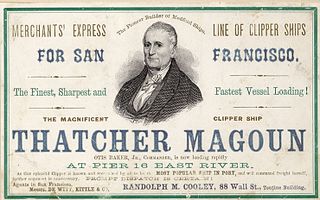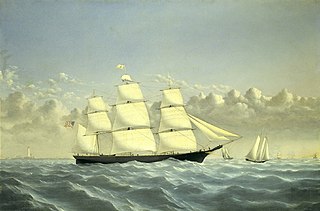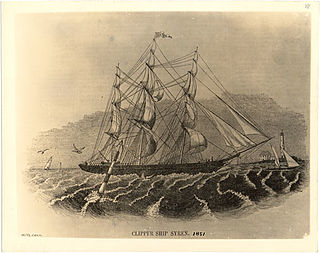
Flying Cloud was a clipper ship that set the world's sailing record for the fastest passage between New York and San Francisco, 89 days 8 hours. The ship held this record for over 130 years, from 1854 to 1989.

James Baines was a passenger clipper ship completely constructed of timber in the 1850s and launched on 25 July 1854 from the East Boston shipyard of the famous ship builder Donald McKay in the United States for the Black Ball Line of James Baines & Co., Liverpool. The clipper was one of the few known larger sailing ships rigged with a moonsail.

Stag Hound was launched on December 7, 1850 in East Boston, Massachusetts. Designed by shipbuilder Donald McKay for the California trade, she was briefly the largest merchant ship in the world. She was in active service from 1851 until her total loss in 1861.

Surprise was a California clipper built in East Boston in 1850. It initially rounded Cape Horn to California, but the vessel's owners, A. A. Low & Brother, soon found that the vessel performed well in Far Eastern waters. From that point onward the vessel spent much of her working life in the China trade, although the vessel also made three trips from the East Coast of the United States to California.

The Young America was built by William H. Webb of New York. She was launched in 1853, at the height of the clipper construction boom. She sailed in the California trade, on transatlantic routes, and made voyages to Australia and the Far East.

White Swallow was an extreme clipper built in Boston in 1853 for the California trade.

The Thatcher Magoun, an extreme clipper launched in 1855, was named after Medford's great shipbuilder, Thatcher Magoun, who died the year that she was launched.

Carrier Dove was an 1855 medium clipper. She was one of two well-known clippers launched in Baltimore that year, the other being Mary Whitridge.

Herald of the Morning was one of the few clipper ships with a passage to San Francisco in less than 100 days.

The Memnon was the first clipper ship to arrive in San Francisco after the Gold Rush, and the only clipper to arrive in San Francisco before 1850. Built in 1848, she made record passages to San Francisco and to China, and sailed in the first clipper race around Cape Horn.

Mary Robinson was an 1854 medium clipper in the San Francisco, India, and the guano trades. She was known for having spent an entire month attempting to round Cape Horn in bad weather.

Lookout was an 1853 clipper known for her passages from New York to San Francisco, and as an offshore and coastal trader in the lumber and coal trades.

Golden West was an 1852 extreme clipper built by Paul Curtis. The ship had a very active career in the California trade, the guano trade, the coolie trade, the Far East, and Australia. She made a record passage between Japan and San Francisco in 1856.

Comet was an 1851 California clipper built by William H. Webb which sailed in the Australia trade and the tea trade. This extreme clipper was very fast. She had record passages on two different routes: New York City to San Francisco, and Liverpool to Hong Kong, and beat the famous clipper Flying Dutchman in an 1853 race around the Horn to San Francisco.

Syren was the longest lived of all the clipper ships, with a sailing life of 68 years 7 months. She sailed in the San Francisco trade, in the Far East, and transported whaling products from Hawaii and the Arctic to New Bedford.

Shooting Star was an extreme clipper built in 1851 near Boston, in Medford, Massachusetts. She was the first "real clipper" to be built in Medford, and sailed in the San Francisco, China, and Far East trades. According to Howe and Matthews, she was known as "one of the fastest of the small clippers".

Golden State was an extreme clipper ship built by Jacob Aaron Westervelt in 1852 in New York City and launched on January 10, 1853. In 1883 she was renamed Anne C. Maguire.

Bald Eagle was a clipper ship launched in 1852 which made four round-trip passages from eastern U.S. ports before being lost on her fifth voyage in the Pacific ocean in 1861. She set the record, 78 days 22 hours, for the fastest passage of a fully loaded ship between San Francisco and New York.

Hurricane was a large extreme clipper of 1608 tons burthen built in Hoboken, New Jersey, United States in 1851. Reputedly the most extreme clipper ever built, Hurricane proved a very fast vessel, reportedly capable of speeds of up to 18 knots (33 km/h) in ideal conditions, and establishing a number of record passages in the early years of her career.
Santa Claus was an American medium clipper ship built in Boston by Donald McKay in 1854. In the course of her career, she made three voyages from the East Coast of the United States to San Francisco, California, the fastest of which was a comparatively swift 128-day passage in the winter of 1857–1858. The ship was mainly engaged in the guano trade and in trade to the Far East. In 1858, she brought Chinese immigrants to California; according to one source, she was also at one time engaged in the coolie trade.




















